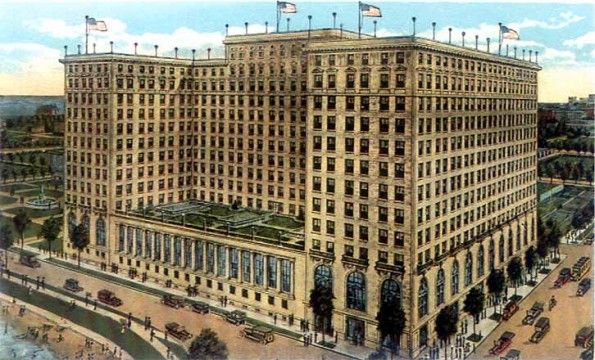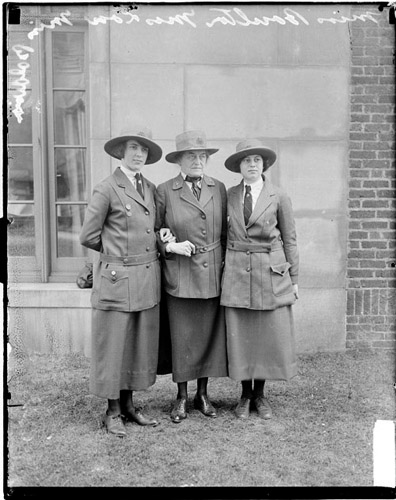In 1924, the tenth annual Girl Scout national conference was held in Chicago, Illinois, at the Drake Hotel. Juliette Gordon Low was happily in the center of things in her role as Founder of the Girl Scouts. It was a busy time. She gave interviews to journalists, telling one that girls faced many challenges and thus “should be equipped, mentally and physically, to endure and to progress and to triumph,” with the help of Girl Scouting. [1]
She presented a formal lecture at the Chicago Historical Society on the topic of “Why the Girl Scouts of Today are the Pioneers of Tomorrow.” The pioneer theme swirled around her because she was a member of the first white family that settled Chicago–the Kinzies.
Reporters like Genevieve Forbes liked to play up the connection. “The 1924 girl plus the girl of the covered wagon days equals the Girl Scout,” she decided. [2] Forbes listened in as Juliette Low and Girl Scout President Lou Henry Hoover discussed the aims of the organization and summarized them succinctly: “A girl should be taught to help her mother without thinking she’s a saint. Wiping dishes doesn’t entitle one to the crown of martyrdom. Hammer, nails, and even an ax have no monopoly on masculine clients. Every girl should be able to build a shelter for herself.” [3] While nicely encapsulating the blend of the traditionally female and male spheres that Girl Scouting offered, Juliette Low probably would have added something about friendship, leadership, and civic duties.
But it was with the five hundred leaders and two thousand girls that Juliette Low really concerned herself. Her dear friend Jane Deeter Rippin, the national director of the organization, was there; so was her goddaughter Anne Hyde Choate. Choate had come to explain “the new order of the Golden Eaglet, which is the highest rank in Girl Scouting” and to award the Golden Eaglet to two hard-working girls. [4]
Today’s leaders will not be surprised that the other order of business was fund raising–$50,000 to be exact. [5] That was an enormous amount of money then.
But if you look closely at that photo, you will see that Juliette Low looks ill. She was. The breast cancer that would overtake her in less than three years had been diagnosed. Nevertheless, she remained determined. She never wanted anyone to pity her and she told very few people the truth about her illness. Thus, returning to Chicago in 1924–where her mother grew up, where she had relatives and memories and a sense of place–must have been bittersweet. She knew her own mortality, and despite her preternatural optimism, she could not always keep her pain hidden. But hers was an unconquerable spirit. Despite the cloud that her cancer cast over that convention, Juliette Gordon Low carried on.
[1] Louise James Bargelt, “Leaders Arrive for Girl Scouts’ National Rally,” Chicago Tribune, 27 April 1924, 4.
[2] Genevive Forbes, “Girl Scouts Taught How to Be Girls,” Chicago Tribune, 29 April 1924, 21.
[3] Forbes, 21.
[4] Bargelt, 4.
[5] Mme. X, “News of Chicago Society,” Chicago Tribune, 2 November 1924, F-1.
Photo of Low with “Miss Baldwin and Miss Boulton” from the Library of Congress American Memory site. Photo of the Drake Hotel from Wikimedia.




Stacy, I subscribe to your posts via email to be sure I don’t miss any… I love that they come from Google Inc, located on West Kinzie in Chicago!
Hi, Becky–
Thanks for your note. I have noticed that West Kinzie connection too. Pretty neat!
Thanks for reading—
I know that Daisy eventually died of Breast Cancer. In examine this picture of her (and I have thought this before), it appears
her right breast is significantly larger than her left. Is there
an explanation?
No idea. Few of us are exactly the same size…
Stacy:
I am currently reading your book on Juliette Gordon Low.
I am fascinated by her circle of friends.
Yours,
Jim Jordan
Thanks, Jim! I was very interested in knowing who her friends were.